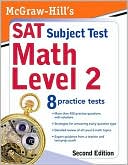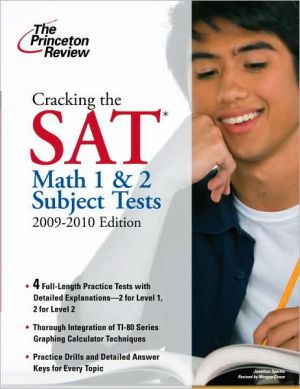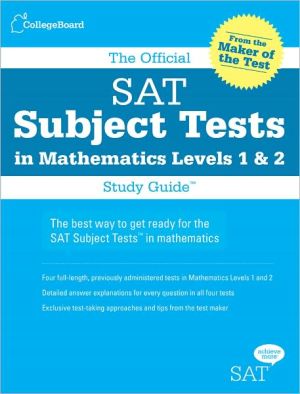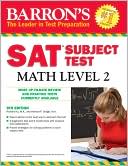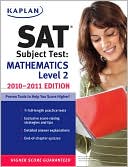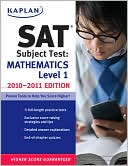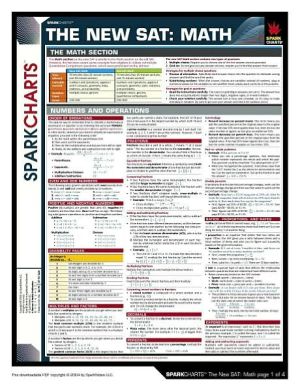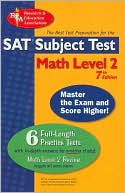McGraw-Hill's SAT Subject Test: Math Level 2
Search in google:
We want to help you score high on the SAT* Math Level 2 testWe've put all of our proven expertise into McGraw-Hill's SAT Subject Test: Math Level 2 to make sure you're fully prepared for this difficult exam. With this book, you'll get essential skill-building techniques and strategies created by leading high school math teachers and curriculum developers. You'll also get 9 full-length practice tests, hundreds of sample problems, and all the facts about the current exam. With McGraw-Hill's SAT Subject Test: Math Level 2, we'll guide you step by step through your preparation program-and give you the tools you need to succeed.9 full-length sample tests with complete explanations for every problem 30 top test items to remember on exam day A step-by-step review of all topics covered on the exam Teacher-recommended tips and strategies to help you raise your score*SAT is a registered trademark of the College Entrance Examination Board, which was not involved in the production of, and does not endorse, this product.
Part I: About the SAT Math Level 2 Test; Chapter 1: Test Basics; About the Math Level 2 Test; When to Take the Test; The Level 1 vs. Level 2 Test; Scoringl; How to Use This Book; Chapter 2: Calculator Tips; On the Day of the Test; Chapter 3: Diagnostic Test; Answer Sheet for the Diagnostic Test; Diagnostic Test Questions; Answer Key; Answers and Solutions; Diagnose Your Key Strengths and Weaknesses; Part II: Math Review; Chapter 4: Algebra; Real Numbers; Absolute Value; Radical Expressions; Polynomials; Quadratic Equations; Inequalities; Rational Expressions; Systems; Binomial Theorem; Chapter 5: Solid Geometry; Vocabulary for Polyhedra; Review of Area Formulas; Prisms; Cylinders; Pyramids; Cones; Spheres ; Volume Ratio of Similar Figures; Coordinates in Three Dimensions; Chapter 6: Coordinate Geometry; Plotting Points; Midpoint; Distance; Slope; Slope of Parallel and Perpendicular Lines; Equations of Lines; Circles; Parabolas; Ellipses; Hyperbolas; Graphing Inequalities; Graphing Absolute Value; Symmetry; Transformations; Polar Coordinates; Chapter 7: Trigonometry; Triangle Trigonometry; Relationships Among Trigonometric Ratios; Special Right Triangles; Trigonometric Identities; Radian Measure; Law of Cosines; Law of Sines; Trigonometric Equations; Double Angle Formulas; Chapter 8: Functions; Function Notation; Functions vs. Relations; Composition of Functions; Determining the Maximum or Minimum; The Roots of a Quadratic Function; Inverse Functions; Rational Functions; Higher-Degree Polynomial Functions; Exponential Functions; Logarithmic Functions; Trigonometric Functions; Inverse Trigonometric Functions; Periodic Functions; Piecewise Functions; Recursive Functions; Parametric Functions; Data Analysis, Statistics, and Probability; Mean, Median, Mode; Range; Interquartile Range; Standard Deviation; Data Interpretation; Regression; Probability; Chapter 10: Number and Operations; Invented Operations; "In Terms of" Problems; Ratio and Proportion; Complex Numbers; Counting Problems; Number Theory; Logic; Matrices; Sequences; Series; Vectors; Limits; Part III: Eight Practice Tests; Practice Test 1; Practice Test 2; Practice Test 3; Practice Test 4; Practice Test 5; Practice Test 6; Practice Test 7; Practice Test 8 John J. Diehl is the chair of the mathematics department at Hinsdale Central High School in Hinsdale, Illinois. He has been a grader of AP Statistics exams and is a member of the AP Statistics Test Development Committee.
